Research on Mechanism and Control of Floor Heave of Mining-Influenced Roadway in Top Coal Caving Working Face
Abstract
1. Introduction
2. Engineering Background
2.1. Engineering Geological Condition
2.2. Roadway Deformation Characteristics
3. Mechanism Analysis of Roadway Floor Heave
3.1. Roadway Deformation Characteristics
3.2. Roadway Deformation Characteristics
4. Optimal Scheme of Roadway
4.1. Theoretical Calculation of Support Parameter Optimization
4.2. Determination of Optimal Support Scheme
5. Numerical Simulation of Deformation and Failure of Roadway Optimization Support
6. The Engineering Application
7. Discuss
8. Conclusions
Author Contributions
Funding
Conflicts of Interest
References
- Yu, W.J.; Wu, G.S.; Liu, H. Deformation characteristics and stability control of soft coal—Rock mining roadway in thin coal seam. J. China Coal Soc. 2018, 43, 2668–2678. [Google Scholar]
- Kang, H.P.; Wang, J.H.; Lin, J. High pretensioned stress and intensive bolting system and its application in deep roadways. J. China Coal Soc. 2007, 32, 1233–1238. [Google Scholar]
- Li, W.T.; Li, S.C.; Xuan, C. Mechanism and control of failure of rock roadway support in highly stressed soft rock. Chin. J. Rock Mech. Eng. 2015, 34, 1836–1848. [Google Scholar]
- Kang, H.P.; Lu, S.L. Research on mechanism of floor heave of roadway. Chin. J. Rock Mech. Eng. 1991, 10, 362–373. [Google Scholar]
- Jiang, Y.D.; Zhao, Y.X.; Liu, W.G. Research on floor heave of roadway in deep mining. Chin. J. Rock Mech. Eng. 2004, 23, 2396–2401. [Google Scholar]
- Bai, J.B.; Li, W.F.; Wang, X.Y. Mechanism of floor heave and control technology of roadway induced by mining. J. Min. Saf. Eng. 2011, 28, 1–5. [Google Scholar]
- Chen, Y.G.; Lu, S.L. China Coal Mine Roadway Surrounding Rock Control; China University of Mining and Technology Press: Xuzhou, China, 1994; pp. 463–469. [Google Scholar]
- Hua, X.Z.; Lu, X.Y.; Li, Y.F. Prevention and control technology of floor heave in gob-side entry retaining with large section of deep mine. Coal Sci. Technol. 2013, 41, 100–104. [Google Scholar]
- Sun, X.M.; Miao, P.Y.; Shen, F.X. Study on floor heave mechanism of horizontal layered soft rock roadway in deep well under different stress states. J. Min. Saf. Eng. 2018, 35, 1099–1106. [Google Scholar]
- Sungsoon, M.; Kudret, T.; Serkan, S. Management of floor heave at Bulga Underground Operations—A case study. Int. J. Min. Sci. Technol. 2019, 29, 73–78. [Google Scholar]
- Zhang, Z.; Shimada, H. Numerical Study on the Effectiveness of Grouting Reinforcement on the Large Heaving Floor of the Deep Retained Goaf-Side Gate road: A Case Study in China. Energies 2018, 11, 1001. [Google Scholar] [CrossRef]
- Gong, P.; Ma, Z.; Ni, X.; Zhang, R.R. Floor Heave Mechanism of Gob-Side Entry Retaining with Fully-Mechanized Backfilling Mining. Energies 2017, 10, 2085. [Google Scholar] [CrossRef]
- Wang, J.; Hu, C.c.; Zuo, J.P. Mechanism of roadway floor heave and control technology in fault fracture zone. J. China Coal Soc. 2019, 44, 397–408. [Google Scholar]
- Wang, G.Y.; Jin, L. Study on dynamic responses of roadway controlled by borehole pressure relief and prestressed grouting anchor cable on the floor under dynamic load. Chin. J. Appl. Mech. 2017, 34, 881–886. [Google Scholar]
- Wang, X.Q.; Kan, J.G.; Jiao, J.K. Mechanism of floor heave in the roadway with high stress and soft rock and its control practice. J. Min. Saf. Eng. 2017, 34, 214–220. [Google Scholar]
- Huang, Q.X.; Hao, G.G. Research on the floor failure range and its effects of entry. J. Xi’an Univ. Sci. Technol. 2018, 38, 51–58. [Google Scholar]
- Hua, X.Z.; Yang, P. Floor deformation dynamic evolution of gob-side entry retaining with large section in deep mine. J. China Univ. Sci. Technol. 2018, 47, 494–501. [Google Scholar]
- Hua, X.Z.; Yang, P.; Liu, Q.J. Model test on evolution mechanism of floor heave in gob-side retaining entry of deep mine. J. Min. Saf. Eng. 2018, 35, 1–9. [Google Scholar]
- Hua, X.Z.; Li, Y.F. Mechanics analysis on floor deformation of gob-side entry retaining and prevention and control of floor heave. J. China Coal Soc. 2016, 41, 1624–1631. [Google Scholar]
- Lai, X.P.; Xu, H.C.; Kang, Y.L. Analysis on “spatio-tempo-intension” evolution rules of overburden strata movement in fully mechanized top-coal caving face. J. Xi’an Univ. Sci. Technol. 2018, 38, 871–877. [Google Scholar]
- Zuo, J.P.; Sun, Y.J.; Li, K. Study of the reinforced supporting length and floor heave control technology of soft rock roadway influenced by collapse column. J. China Univ. Min. Technol. 2017, 46, 18–26. [Google Scholar]
- Shan, P.F.; Lai, X.P. Mesoscopic structure PFC~2D model of soil rock mixture based on digital image. J. Vis. Commun. Image Represent. 2019, 58, 407–415. [Google Scholar] [CrossRef]
- Shan, P.F.; Lai, X.P.; Liu, X.M. An associated evaluation methodology of initial stress level of coal-rock masses in steeply inclined coal seams, Urumchi coal field, China. J. Eng. Comput. 2020. [Google Scholar] [CrossRef]
- Zhang, N.; Shi, X.L.; Zhang, Y. Tightness analysis of underground natural gas and oil storage caverns with limit pillar widths in bedded rock salt. J. IEEE ACCESS 2020. [CrossRef]
- Chen, Z.Y.; Zhou, J.X.; Wang, H.J. Soil Mechanics; Tsinghua University Press: Beijing, China, 1992. [Google Scholar]
- Qian, M.G.; Shi, P.W. Mine Pressure and Strata Control; China University of Mining and Technology Press: Xuzhou, China, 2003. [Google Scholar]
- Hou, C.J.; He, Y.N.; Li, X. Reinforcing sidewalls and corners of gateway to control floor heave. J. China Coal Soc. 1995, 20, 229–234. [Google Scholar]
- Huang, Q.X.; Zheng, C. Theory of self stable ring in roadway support. Rock Soil Mech. 2016, 37, 1231–1236. [Google Scholar]
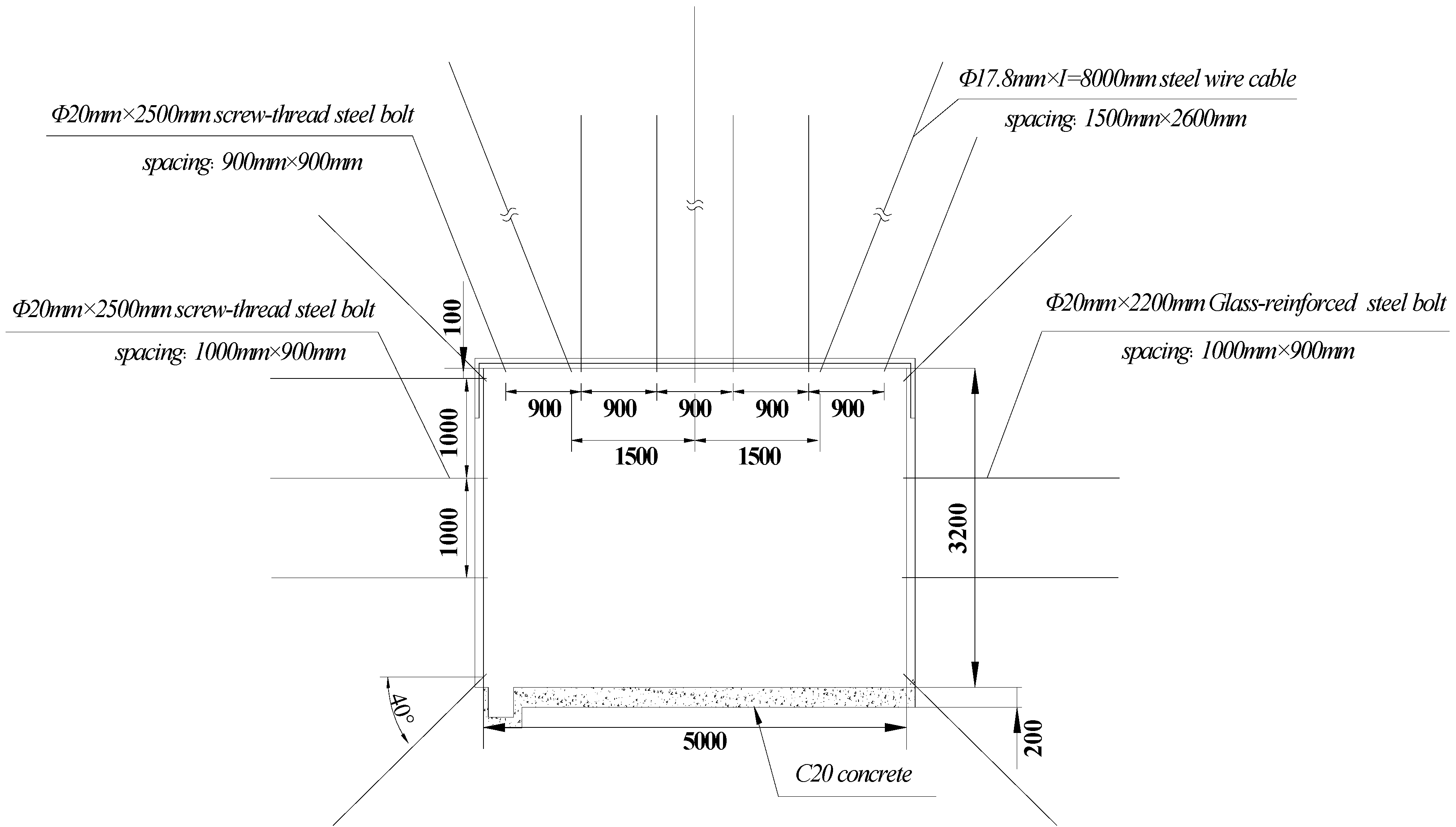

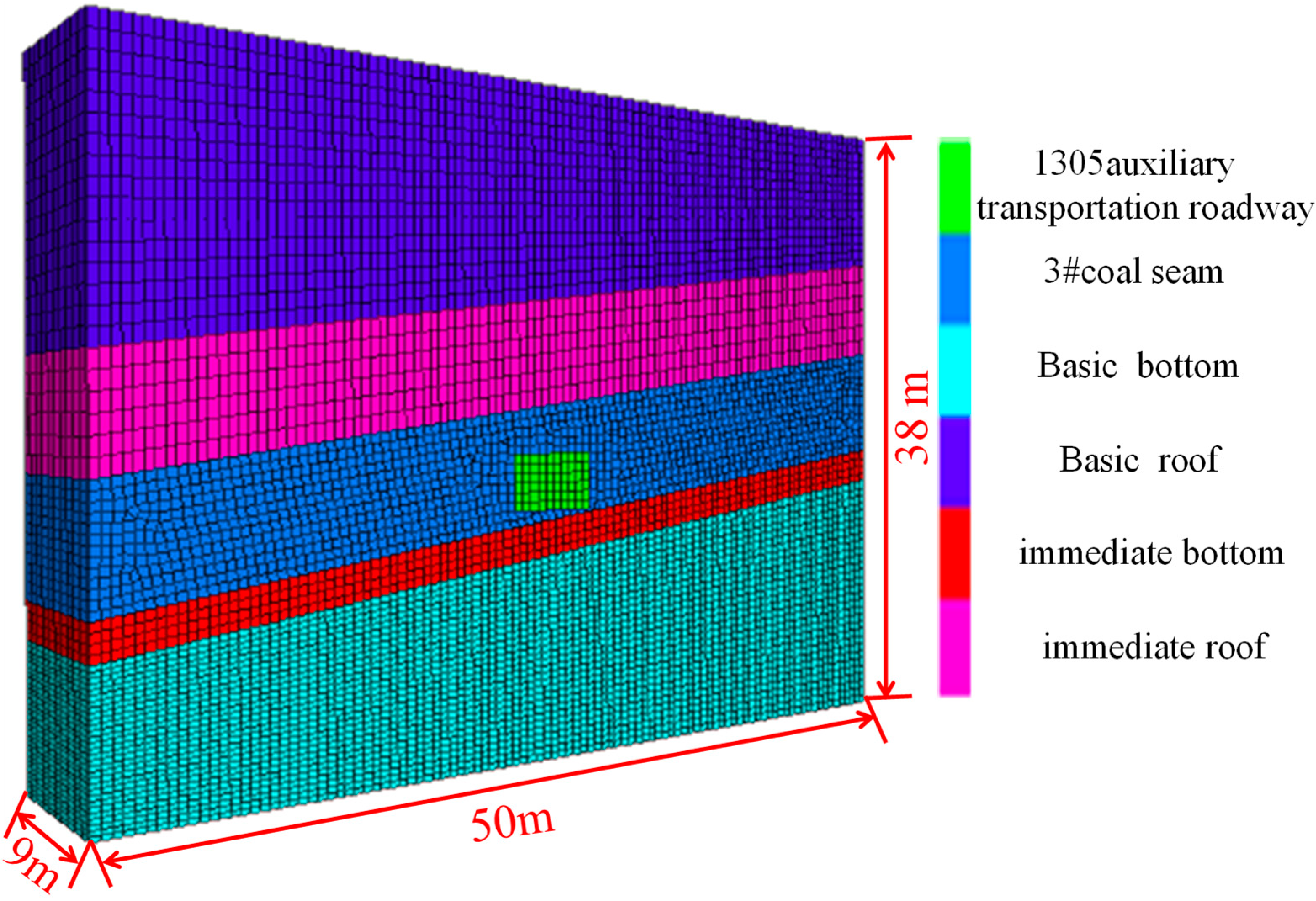
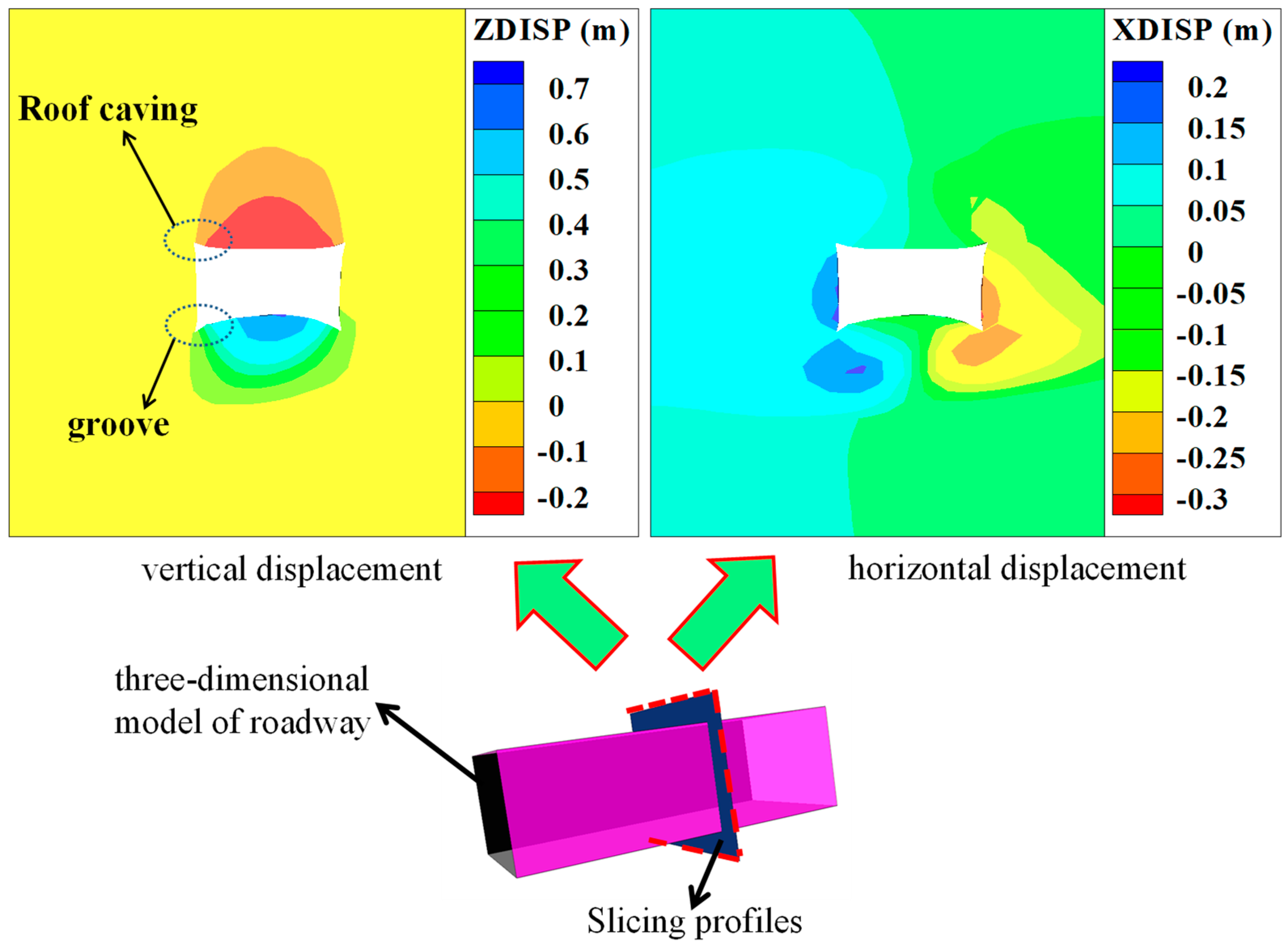
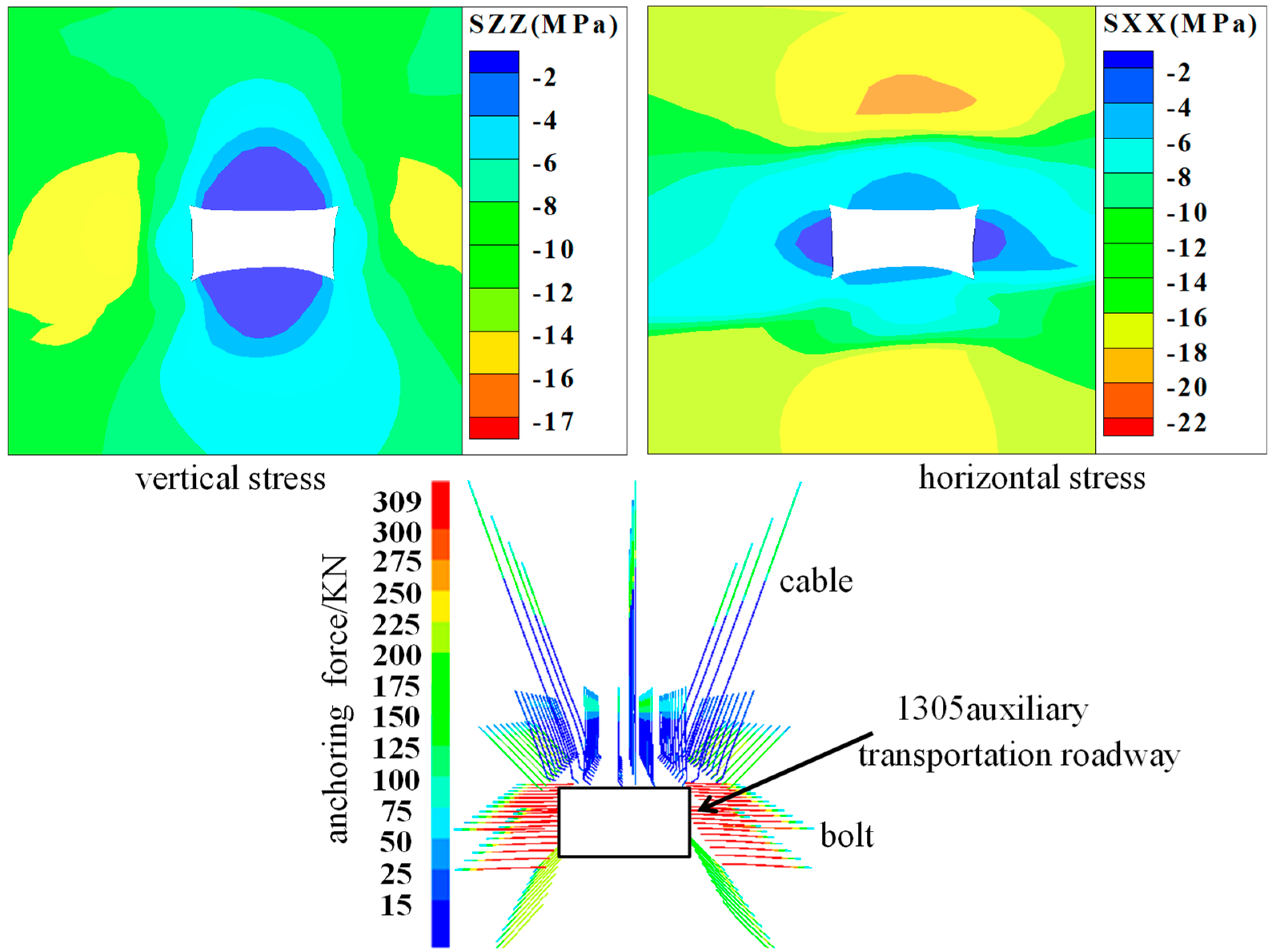

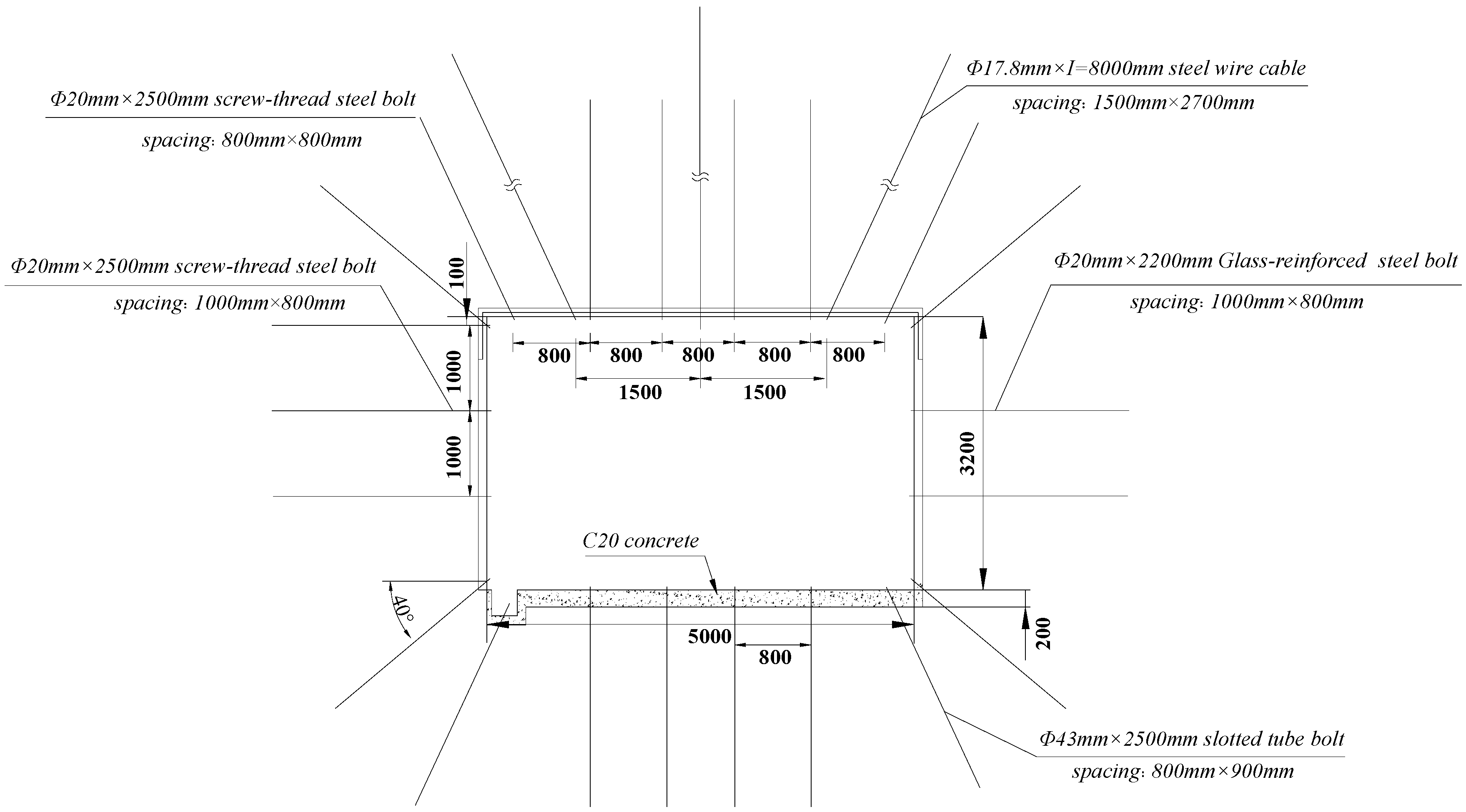
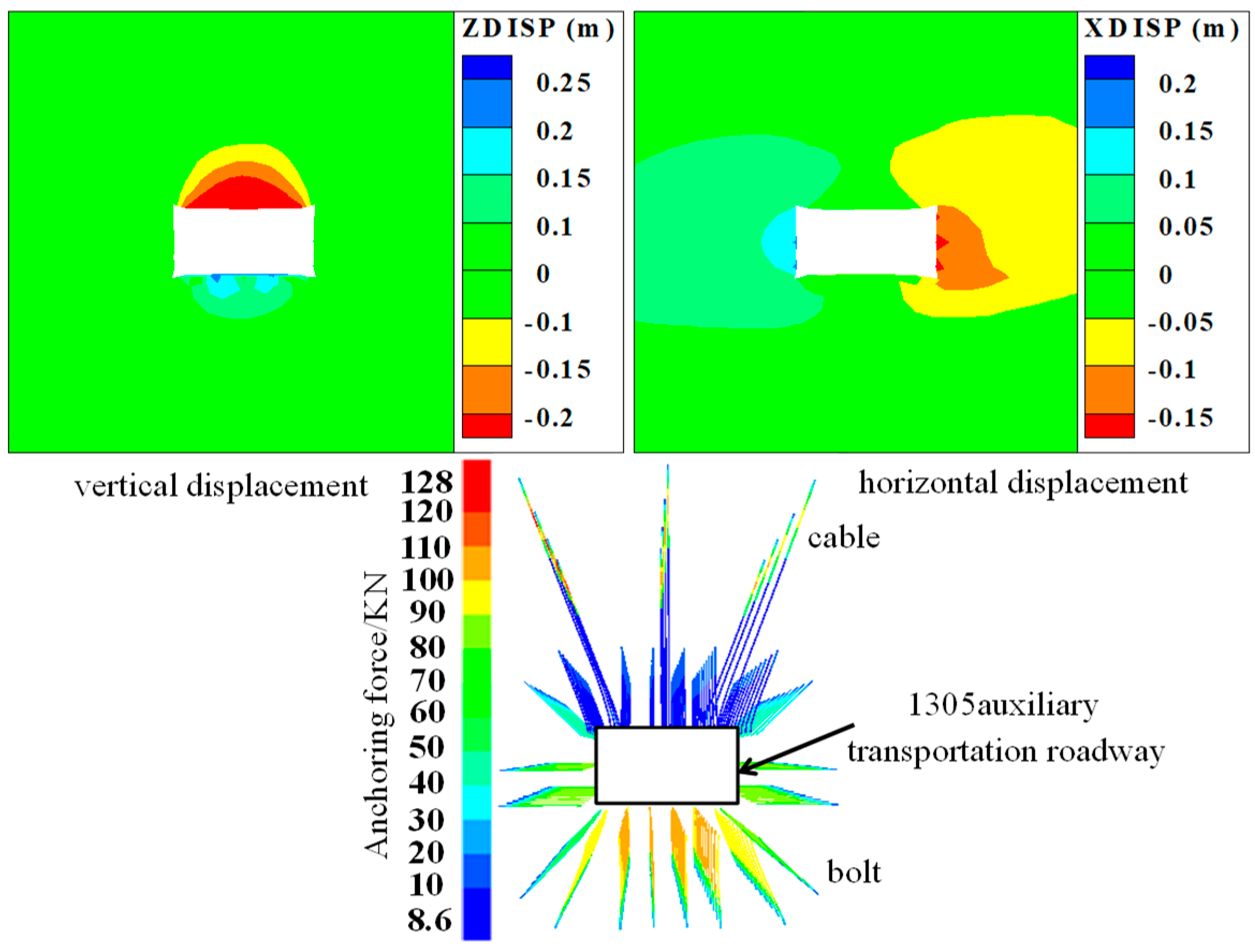

| Density (kg·m−3) | Cohesion (MPa) | Angle of Internal Friction (º) | Bulk E (GPa) | Shear E (GPa) | Tension (MPa) | |
|---|---|---|---|---|---|---|
| Basic Roof | 2100 | 5.35 | 30 | 7.8 | 2.8 | 0.34 |
| Immediate Roof | 2220 | 3.2 | 29.9 | 6.8 | 2.4 | 0.48 |
| #3 Coal Seam | 1300 | 2.02 | 27.4 | 4.4 | 0.5 | 0.45 |
| Immediate Bottom | 2060 | 2.57 | 28.6 | 6.8 | 1.9 | 0.42 |
| Basic Bottom | 2120 | 3.07 | 28.2 | 6.8 | 1.9 | 0.33 |
| Maximum Failure Depth of the Floor | Borehole Observation Results | Numerical Simulation Results | Calculation Results of Mechanical Model |
|---|---|---|---|
| 3.0 m | 3.4 m | 3.2 m |
© 2020 by the authors. Licensee MDPI, Basel, Switzerland. This article is an open access article distributed under the terms and conditions of the Creative Commons Attribution (CC BY) license (http://creativecommons.org/licenses/by/4.0/).
Share and Cite
Lai, X.; Xu, H.; Shan, P.; Kang, Y.; Wang, Z.; Wu, X. Research on Mechanism and Control of Floor Heave of Mining-Influenced Roadway in Top Coal Caving Working Face. Energies 2020, 13, 381. https://doi.org/10.3390/en13020381
Lai X, Xu H, Shan P, Kang Y, Wang Z, Wu X. Research on Mechanism and Control of Floor Heave of Mining-Influenced Roadway in Top Coal Caving Working Face. Energies. 2020; 13(2):381. https://doi.org/10.3390/en13020381
Chicago/Turabian StyleLai, Xingping, Huicong Xu, Pengfei Shan, Yanlei Kang, Zeyang Wang, and Xuan Wu. 2020. "Research on Mechanism and Control of Floor Heave of Mining-Influenced Roadway in Top Coal Caving Working Face" Energies 13, no. 2: 381. https://doi.org/10.3390/en13020381
APA StyleLai, X., Xu, H., Shan, P., Kang, Y., Wang, Z., & Wu, X. (2020). Research on Mechanism and Control of Floor Heave of Mining-Influenced Roadway in Top Coal Caving Working Face. Energies, 13(2), 381. https://doi.org/10.3390/en13020381





